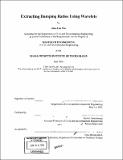| dc.contributor.advisor | Kevin Amaratunga. | en_US |
| dc.contributor.author | Wu, Jiun-Yan, 1972- | en_US |
| dc.contributor.other | Massachusetts Institute of Technology. Dept. of Civil and Environmental Engineering. | en_US |
| dc.date.accessioned | 2005-08-23T21:45:38Z | |
| dc.date.available | 2005-08-23T21:45:38Z | |
| dc.date.copyright | 2001 | en_US |
| dc.date.issued | 2001 | en_US |
| dc.identifier.uri | http://hdl.handle.net/1721.1/8618 | |
| dc.description | Thesis (M.Eng.)--Massachusetts Institute of Technology, Dept. of Civil and Environmental Engineering, 2001. | en_US |
| dc.description | Includes bibliographical references (leaves 87-88). | en_US |
| dc.description.abstract | The focus of this work is to evaluate the accuracy of methods for extracting damping ratios with respect to: three extraction methods, different damping ratios, added noisy data, separated modes and close modes. To achieve this goal, a simulated analytical signal is analyzed by estimating the modal parameters. The simulated analytic signal is useful because the exact values are known and the characteristic of the FRF can be varied in order to observe how the accuracy of damping ratios is affected. Results show that the Continuous Wavelet Transform method gives the most accurate estimations even for data corrupted by the noise. The Complex Exponential method presents better results in the cases with higher modes and higher damping ratios without the noise. Wavelet Packet method and Continuous Wavelet Transform method are more suitable in the cases for extracting lower damping ratios than those for higher damping ratios even for data corrupted by the noise. And in general, the estimation results are more accurate in the cases with separated modes than those with close modes. | en_US |
| dc.description.statementofresponsibility | by Jiun-Yan Wu. | en_US |
| dc.format.extent | 88 leaves | en_US |
| dc.format.extent | 4846719 bytes | |
| dc.format.extent | 4846477 bytes | |
| dc.format.mimetype | application/pdf | |
| dc.format.mimetype | application/pdf | |
| dc.language.iso | eng | en_US |
| dc.publisher | Massachusetts Institute of Technology | en_US |
| dc.rights | M.I.T. theses are protected by copyright. They may be viewed from this source for any purpose, but reproduction or distribution in any format is prohibited without written permission. See provided URL for inquiries about permission. | en_US |
| dc.rights.uri | http://dspace.mit.edu/handle/1721.1/7582 | |
| dc.subject | Civil and Environmental Engineering. | en_US |
| dc.title | Extracting damping ratios using wavelets | en_US |
| dc.type | Thesis | en_US |
| dc.description.degree | M.Eng. | en_US |
| dc.contributor.department | Massachusetts Institute of Technology. Department of Civil and Environmental Engineering | |
| dc.identifier.oclc | 49521596 | en_US |
